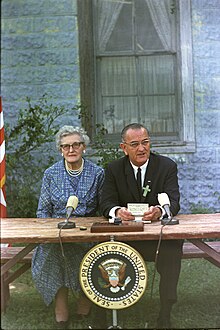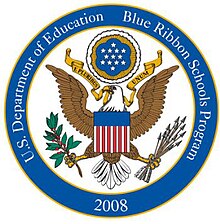Education reform is the name given to the goal of changing public education. The meaning and education methods have changed through debates over what content or experiences result in an educated individual or an educated society. Historically, the motivations for reform have not reflected the current needs of society. A consistent theme of reform includes the idea that large systematic changes to educational standards will produce social returns in citizens' health, wealth, and well-being.

The United States Department of Education is a cabinet-level department of the United States government. It began operating on May 4, 1980, having been created after the Department of Health, Education, and Welfare was split into the Department of Education and the Department of Health and Human Services by the Department of Education Organization Act, which President Jimmy Carter signed into law on October 17, 1979.

The No Child Left Behind Act of 2001 (NCLB) was a U.S. Act of Congress promoted by the Presidency of George W. Bush. It reauthorized the Elementary and Secondary Education Act and included Title I provisions applying to disadvantaged students. It mandated standards-based education reform based on the premise that setting high standards and establishing measurable goals could improve individual outcomes in education. To receive federal school funding, states had to create and give assessments to all students at select grade levels.
Adequate Yearly Progress (AYP) was a measurement defined by the United States federal No Child Left Behind Act that allowed the U.S. Department of Education to determine how every public school and school district in the country was performing academically according to results on standardized tests. As defined by National Council on Measurement in Education (NCME), AYP was "the amount of annual achievement growth to be expected by students in a particular school, district, or state in the U.S. federal accountability system, No Child Left Behind (NCLB)." AYP has been identified as one of the sources of controversy surrounding George W. Bush administration's Elementary and Secondary Education Act. Private schools were not required to make AYP.
A Pell Grant is a subsidy the U.S. federal government provides for students who need it to pay for college. Federal Pell Grants are limited to students with exceptional financial need, who have not earned their first bachelor's degree, or who are enrolled in certain post-baccalaureate programs, through participating institutions. Originally known as a Basic Educational Opportunity Grant, it was renamed in 1980 in honor of Democratic U.S. Senator Claiborne Pell of Rhode Island. A Pell Grant is generally considered the foundation of a student's financial aid package, to which other forms of aid are added. The Federal Pell Grant program is administered by the United States Department of Education, which determines the student's financial need and through it, the student's Pell eligibility. The U.S. Department of Education uses a standard formula to evaluate financial information reported on the Free Application for Federal Student Aid (FAFSA) for determining the student's Expected Family Contribution (EFC).

The Bilingual Education Act (BEA), also known as the Title VII of the Elementary and Secondary Education Amendments of 1967, was the first United States federal legislation that recognized the needs of limited English speaking ability (LESA) students. The BEA was introduced in 1967 by Texas senator Ralph Yarborough and was both approved by the 90th United States Congress and signed by President Lyndon B. Johnson on January 2, 1968. While some states, such as California and Texas, and numerous local school districts around the country already had policies and programs designed to meet the special educational needs of elementary and secondary school students not fluent in the English language, this act signaled that the federal government now also recognized the need for and value of bilingual education programs in U.S. public education. In 1969 there was a 50% drop out rate among Mexican American students who struggled to keep up with their English-speaking peers in school; Representative Tony Abril argued that the Bilingual Education Act would reduce this number. Passed on the heels of the Civil Rights Movement, its purpose was to provide school districts with federal funds, in the form of competitive grants, to establish innovative educational programs for students with limited English speaking ability.
Special education in the United States enables students with exceptional learning needs to access resources through special education programs. These programs did not always exist. "The idea of excluding students with any disability from public school education can be traced back to 1893, when the Massachusetts Supreme Court expelled a student merely due to poor academic ability". This exclusion would be the basis of education for all individuals with special needs for years to come. In 1954, Brown v. Board of Education sparked the belief that the right to a public education applies to all individuals regardless of race, gender, or disability. Finally, special education programs in the United States were made mandatory in 1975 when the United States Congress passed the Education for All Handicapped Children Act (EAHCA) "(sometimes referred to using the acronyms EAHCA or EHA, or Public Law 94-142) was enacted by the United States Congress in 1975, in response to discriminatory treatment by public educational agencies against students with disabilities." The EAHCA was later modified to strengthen protections to students with disabilities and renamed the Individuals with Disabilities Education Act (IDEA). IDEA requires states to provide special education and related services consistent with federal standards as a condition of receiving federal funds.
The Colorado Student Assessment Program (CSAP) was an assessment required by the No Child Left Behind Act administered by the Unit of Student Assessment in the Colorado Department of Education (CDE). The CSAP was designed to measure how well students are learning material from the Colorado Model Content Standards, the established content standards that all Colorado public school students should learn. The CSAP only tested four of the thirteen subject areas in the Colorado Model Content Standards.
The English Language Acquisition, Language Enhancement, and Academic Achievement Act - formerly known as the Bilingual Education Act - is a federal grant program described in Title III Part A of the federal Elementary and Secondary Education Act (ESEA), which was reauthorized as the No Child Left Behind Act in 2002 and again as the Every Student Succeeds Act in 2015. This section is specifically targeted to benefit Limited English Proficient (LEP) children and immigrant youth. The statute states that LEP students must not only attain English proficiency but simultaneously meet the same academic standards as their English-speaking peers in all content areas. Federal funding is provided to assist State Education Agencies (SEAs) and Local Education Agencies (LEAs) in meeting these requirements. In 2011, ESEA Title III awards were granted to 56 SEAs and the average award given to an individual SEA was $12,158,046.

Literacy in the United States was categorized by the National Center for Education Statistics into different literacy levels, with 92% of American adults having at least "Level 1" literacy in 2014. Nationally, over 20% of adult Americans have a literacy proficiency at or below Level 1. Adults in this range have difficulty using or understanding print materials. Those on the higher end of this category can perform simple tasks based on the information they read, but adults below Level 1 may only understand very basic vocabulary or be functionally illiterate. According to a 2020 report by Gallup based on data from the U.S. Department of Education, 54% of adults in the United States lack English literacy proficiency.
The 21st Century Community Learning Centers initiative is the only federal funding source dedicated exclusively to afterschool programs. The No Child Left Behind Act (NCLB) reauthorized 21st CCLC in 2002, transferring the administration of the grants from the U.S. Department of Education to the state education agencies. Each state receives funds based on its share of Title I funding for low-income students. Funds are also allotted to outlying areas and the Bureau of Indian Affairs.The No Child Left Behind Act narrowed the focus of 21st CCLC from a community learning center model, where all members of the community benefited from access to school resources such as teachers, computer labs, gymnasiums and classrooms, to an afterschool program model that provides services only to students attending high-poverty, low-performing schools. The services they provide include Academic enrichment activities that can help students meet state and local achievement standards. They also provide additional services designed to reinforce and complement the regular academic program, such as: drug and violence prevention programs, counseling programs, art, music, and recreation programs, technology education programs, and character education programs. Programs also may provide literacy and related educational development services to the families of children who are served in the program.
School Improvement Grants (SIGs) are grants awarded by the U.S. Department of Education to state education agencies (SEAs) under Section 1003(g) of the Elementary and Secondary Education Act of 1965. The SEAs, in turn, award subgrants to local educational agencies for the purpose of supporting focused school improvement efforts. In 2009, the Obama administration, and specifically U.S. Secretary of Education Arne Duncan, challenged the education community to make the lowest-achieving schools its highest priority.
Student Achievement and School Accountability Programs (SASA) is a division of the Office of Elementary and Secondary Education (OESE) of the U.S. Department of Education (ED) that administers programs of financial assistance to State and local education agencies (LEA) and to colleges and universities. Under Title I of the Elementary and Secondary Education Act (ESEA) of 1965, SASA administers several Title I programs of supplementary instruction and other services. This includes programs such as the Improving Basic Programs Operated by LEAs and the Prevention and Intervention Programs for Children Who are Neglected, Delinquent, or At-Risk. Under Title III of the ESEA, SASA administers the State Formula Grant Program for English Language Acquisition and Language Enhancement. SASA also administers the Education for Homeless Children and Youth program authorized by the McKinney–Vento Homeless Assistance Act.

The Native American Languages Act of 1990 (NALA) is a US statute that gives historical importance as repudiating past policies of eradicating indigenous languages of the Americas by declaring as policy that Native Americans were entitled to use their own languages. The fundamental basis of the policy's declaration was that the United States "declares to preserve, protect and promote the rights and freedom of Native Americans to use practice and develop Native American Languages".
The Turnaround Model is one of four strategies available to American local education agencies (LEAs) under the Race to the Top and School Improvement Grants programs of the Obama administration. The other three programs include Restart, Transformation, and School Closures.
The highly qualified teacher provision is one of the goals of the No Child Left Behind Act (NCLB) of 2001. The term highly qualified teachers (HQT) comes from the original language of Title II of the No Child Left Behind Act. Title II of NCLB designates federal funds to educational agencies for the purpose of improving the student achievement through the professional development of highly qualified teachers and principals. To qualify for this funding, states must comply with a series of conditions stipulated in NCLB, and track their progress toward goals each state sets. Title II was originally known as the Eisenhower Professional Development Program, and has undergone several reauthorizations, though the original intent has remained relatively intact. The main goals of the highly qualified teacher provision is to ensure that every classroom is staffed by a teacher deemed "highly qualified" under conditions set by NCLB. As some point out, this section of NCLB is quite at odds with the general thrust of NCLB because it focuses on school inputs rather than student outcomes. The sections of NCLB designated to HQTs allocates the majority of the funds to the states and does not clearly define at the federal level what is and what is not a highly qualified teacher, allowing for more local definitions of this term. This provision has come under much scrutiny, as it is up to states to decide how to measure highly qualified, and states are not holding their teachers to the same level of rigor across the country. Since its reauthorization in 2001, Title II has yet to reach its stated goal of ensuring that 100% of teachers in public schools in the United States are highly qualified.

The Every Student Succeeds Act (ESSA) is a US law passed in December 2015 that governs the United States K–12 public education policy. The law replaced its predecessor, the No Child Left Behind Act (NCLB), and modified but did not eliminate provisions relating to the periodic standardized tests given to students. Like the No Child Left Behind Act, ESSA is a reauthorization of the 1965 Elementary and Secondary Education Act, which established the federal government's expanded role in public education.
The 1981 Education Consolidation and Improvement Act (ECIA) reauthorized the Elementary and Secondary Education Act (ESEA), significantly deregulating education in the United States and shifting a number of responsibilities back to the state level. As part of the Reagan administration’s Omnibus Reconciliation Act of 1981, this act curtailed federal intervention and funding for domestic social causes while expanding the role of state and local government in administering education. This deregulation is symbolized by the reduced size of Title I, which was reduced from 75 pages to just 14.
The federal government of the United States has limited authority to act on education, and education policy serves to support the education systems of state and local governments through funding and regulation of elementary, secondary, and post-secondary education. The Department of Education serves as the primary government organization responsible for enacting federal education policy in the United States.

The Education for Economic Security Act is a United States federal education law that was enacted in 1984. It provided funding for programs to support schools and teachers in the instruction of math and science, including grants, awards, and scholarships. The act funded teacher training programs and awarded schools and teachers that excelled in the instruction of math and science. The act also developed a program to combat asbestos in schools, fund magnet schools, and protect students from religious discrimination.





